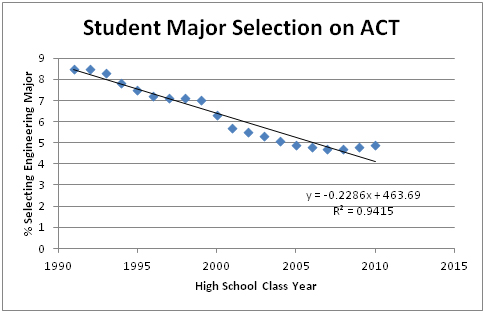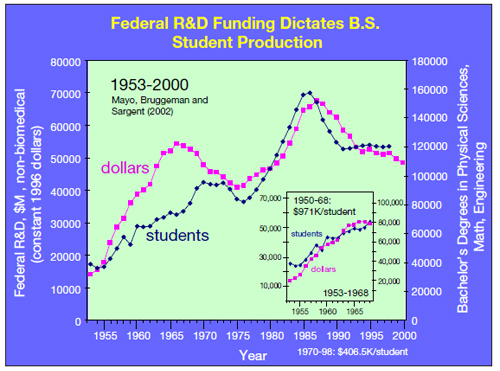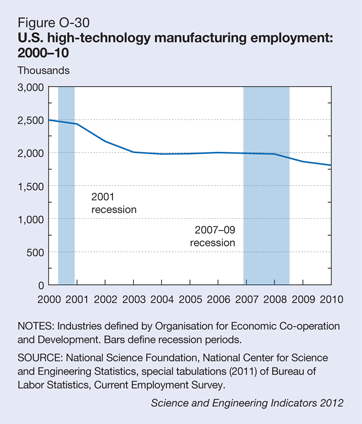
A Texas housewife and President Obama held a video conference on 30 January [17]. Mrs. Jennifer Wedel spoke truth to power as she explained that her husband had been laid off and was unable to find another job in the semi-conductor industry within the Dallas metropolitan area. This was contrary to the President’s assertions to Mrs. Wedel claim that there was a shortage of engineers, reflecting his call for green cards for graduating foreign students in his State of the Union Address less than a week earlier [16]. The President, reacting quickly during the interview, apparently determined that his preconceptions might be in error and offered to circulate Jennifer’s husband’s resume.
The Department of Labor predictions for the decade (2008-2018) projected 1 percent growth and virtually zero growth for electrical and electronics jobs, respectively, and 11 percent overall job growth across all engineering fields [21]. The United States produces almost four times as many engineers annually, without adding immigration [22]. Mrs. Wedel’s admirable courage forces each of us to ponder the wide gap between beliefs about the tech industry and the realities on the street.
Compelling arguments against the temporary H-1B visa program have long been provided, most notably by two tireless scholars, Norman Matloff [1, 2] and Ron Hira [3]. This visa program has frustrated both American job seekers and visa holders [9]. Although IEEE-USA has been and continues to be critical of the H-1B visa program [4], it is currently pushing to expand permanent resident visa programs [6].
The H-1B visa program, as we know it today, was created to support business (and politicians’) claims that they could not find enough qualified employees. The myth of the qualified labor shortage grew during late 1980s with the Y2K bug and peaked in the 1990s during the dot.com boom. Many of the initial misconceptions about the perceived labor shortage were due to flawed analysis by the National Science Foundation in the 1980s [25]. The Millennium bug passed without incident and the dot.com bubble burst, and the labor market expanded and contracted, but claims of shortages persist [5].
Although the business claim is flawed, some aspects of the issue cannot be casually dismissed. For example, American university graduate programs in engineering today are dominated by foreign nationals as demonstrated in a table from a study sponsored by the Semiconductor Industries Association [7]. This table lists the top 25 universities from which the 2008 class of American engineering PhDs earned their bachelor’s degrees. Less than 5 percent of these PhDs are products of American universities.
The purported lack of skilled employees is buoyed by a perception of a decline in American competitiveness, as famously addressed by the National Academies in a lengthy list of policy recommendations in 2007 [10]. In response to the alleged shortages of qualified American engineers and technology professionals, numerous initiatives have been launched to boost interest in STEM (Science, Technology, Engineering and Math) careers and to strengthen STEM education in the United States. Unfortunately, these programs have not proven successful, and many blame the laziness of modern students, the ineptitude of their teachers, poor parenting or, when there are no more other excuses remaining, they may even jump to moral decay as a causative agent. However, the failure of STEM is due to the fact that the very policies that created the shortages continue unabated. This is not a uniquely American problem [8]. The best way to increase interest in STEM degrees is by making certain that STEM careers are actually viable. Several years ago, I attended an NCAA women’s soccer game between Santa Clara and Stanford, and I asked the nearby undergraduates if any of them were majoring in engineering. The response was, “Why would anyone major in engineering?” Ralph Wyndrum, the 2006 President of IEEE-USA once said, “We engineers would do this for free.” I believe that Ralph meant that he, and the community of dedicated volunteers within IEEE, was predestined to do engineering work. Not every student can be expected to share such enthusiasm. Figure 1 shows a plot of declining student interest in engineering provided by the ACT, Inc. testing services company.

Figure1 – High School students on engineering
A very simple plot of historical federal investment in R&D (Figure 2 below) shows a correlation with production of American STEM graduates. [11] In recent years, American investment in R&D has been on a downward trend.

Figure 2. The graph that (may have helped) launch hundreds of
thousands of dollars in R&D funding.
Source: Merrilea J. Mayo, MRS Bulletin (Vol. 32, July 2007)
It is not just undergraduates and high school students who do not understand what engineering careers entail. When employers tell politicians that they cannot find qualified engineers, one of the problems is that the definition of engineer is itself being abused. The dot.com executives mean something different by engineer than an aerospace company may mean by the title engineer. Engineering degrees programs are accredited by ABET (formerly known as the Accreditation Board for Engineering and Technology) [13]. In addition, engineers who face the public are required to hold an engineering license in all states and territories [14]. Software engineering is not yet uniformly licensed, but IEEE-USA has been working with NCEES, the IEEE Computer Society, NSPE and the state of Texas to develop a licensing examination for software engineers that could eventually be adopted by states’ licensing boards [15]. Many employers allow the title software engineer to be applied to their employees who only have private certifications. The growth of software jobs and relatively little regulation created a cottage industry that is focused on creating certification programs. Growing corporate use of outsourced hiring agencies (rather than hiring managers themselves), who seek congruence between job candidates and these new certifications, further adds to the confusion. With the certification programs, various academic accreditation agencies, licensing requirements and misconstrued job titles, it is no wonder that the semantic trap of defining engineer almost caught President Obama in his discussion with Mrs. Wedel.
My own belief is that business practices created this engineering skill shortage problem by adherence to a business mythology, and that government policies are exacerbating the problem. An underlying issue in this mythology is businesses fad (fashion). Examples of fads include the responses to perceived Japanese competitive advantages in the 1980s by the massive investment in quality programs, the reengineering fad of the 1990s (consisting of deployment of enterprise resource planning software coincident with massive layoffs and outsourcing), massive efforts to combat the Y2K bug, speculative investment in dot.coms, and the more recent investment craze in social networks. Business thought is replete with mythology.
Another business mythology is our national preference for a so-called service economy over manufacturing. The business concept is that we can outsource manufacturing to the developing world where recurring costs (the assembly labor) are lower, because, somehow, we seem to believe that there is more value in providing services than in the goods created. This belief has resulted in wholesale technology transfer out of the United States [12, 18], and many Americans have such poor technology history knowledge that they believe that the outsourced products were invented and developed in these outsource countries. How could anyone be surprised that American innovation is slowing [19]?
So how are we doing in the high tech sector? According to the latest NSF Science and Engineering Indicators, employment in the five U.S. high-technology manufacturing sectors reached a peak in 2000.The total job loss in high technology manufacturing over the period (2000-2010), illustrated below in Figure 0-30, was 687,000—a decline of 28 percent since 2000 [26]. Ironically, this is almost the same number (675,000) of alleged shortfall of scientists and engineers, as reported by NSF in 1989 (but in the wrong direction).

I call on interested U.S. IEEE members to become engaged in helping to formulate IEEE-USA’s policy positions, because my interaction with IEEE colleagues in Silicon Valley has taught me that we IEEE members have real power to influence. It is time to use that power [20].
References:
-
Matloff, N., Debunking the Myth of a Desperate Software Labor Shortage, Testimony to the House Judicial Committee Subcommittee on Immigration, 21 April 1998.
-
Matloff, N., The University of Michigan Journal of Law Review, Vol. 36, No. 1, Dec. 2003.
-
Hira, R., Bridge to Immigration or Cheap Temporary Labor, EPI Briefing Paper 257, Economic Policy Institute, 17 Feb 2010.
-
Perrotti, D., H-1B Battle: The war Within IEEE, Computerworld, 25 Sept 2007.
-
Bort, J., H-1B visas need to be easier to get, business leaders tell Congress, Network World, April 2011.
-
IEEE-USA, Public Policy Priority Issues – 112th Congress, 1st Session (2011), https://www.ieeeusa.org/policy/issues/ (accessed 23 Feb 2011).
-
Dewey & LeBeouf, Maintaining America’s Competitive Edge: Government Policies Affecting Semiconductor Industry R&D and Manufacturing Activity, SIA, March 2009, p 30.
-
Becker, F., “Why Don’t Young People Want to Become Engineers? Rational Reasons for Disappointing Decisions,” European Journal of Engineering Education, Vol. 35 , Number 4, pp. 349-366.
-
O’Brien, M., High-tech New Citizens Bemoan Long Path to Ceremony, Mercury News, 22 Feb, 2012.
-
Committee on Science Engineering and Public Policy, Rising Above the Gathering Storm: Energizing and Employing America for a Brighter Economic Future, The National Academy Press, 2007.
-
Nucci, J. (interview with Mayo, M.), Materials Researcher Measures Success by Enacting Change in Government Policy, MRS Bulletin, Vol. 32, July 2007, p 586.
-
Elkus, R., Winner Take All: How Competiveness Shapes the Fate of Nations, Basic Books, 2008.
-
About ABET, https://www.abet.org/about-abet/.
-
About NCEES, https://www.ncees.org/About_NCEES.php.
-
NCEES Approves New PE Exam in Software Engineering, 10 September 2009, https://www.ncees.org/About_NCEES/News/News_Pages/
`NCEES_approves_new_PE_exam_in_software_engineering.php -
The 2012 State of the Union, https://www.whitehouse.gov/state-of-the-union-2012
-
Your Interview with the President – 2012, YouTube, https://www.youtube.com/watch?v=eeTj5qMGTAI&feature=relmfu
-
Grove, A., How to Make American Jobs Before It’s Too Late, Bloomberg, 1 July 2010.
-
Greenstone, M. and Looney, A., A Dozen Economic Facts About Innovation, Brookings, Aug 2011.
-
Donahoe, D. Wright, M., Growing Utah’s Economy via Technology Guilds, 2012 Utah Engineers Council Journals, pp. 21-24.
-
Bureau of Labor Statistics, Occupational Outlook Handbook, 2010-2011 Edition, pp. 165-169.
-
National Science Board, Science and Engineering Indicators 2010, 15 Jan 2010, p. 2-16.
-
Email from Ty Cruce, ACT Inc., 24 Feb 2012.
-
Noeth, R., Cruce, T., Harmston, M., Maintaining a Strong Engineering Workforce, ACT Policy Report, 2003.
-
Hicks, D., Science Policy Workshop on Science, Technology, Engineering and Mathematics (STEM) Enterprise: Measures for Innovation and Competitiveness at George Washington University, 21 Oct 2009, p 78.
-
National Science Foundation, Science and Engineering Indicators 2012, p. O-16.






